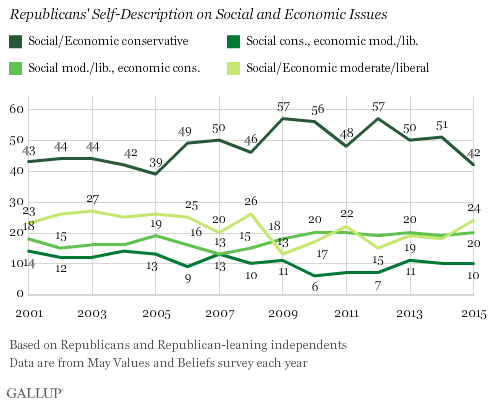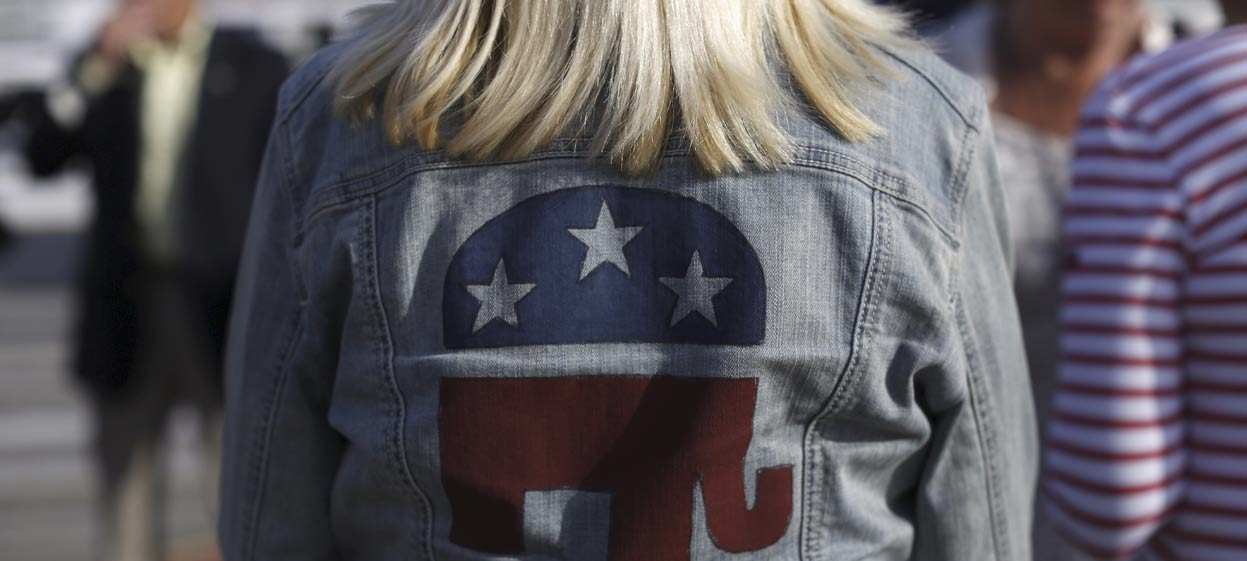Story Highlights
- Fewer Republicans are socially and economically conservative
- Almost one in four in GOP are moderate/liberal on both dimensions
- 20% are socially moderate/liberal but economically conservative
PRINCETON, N.J. -- The percentage of Republicans and Republican-leaning independents who describe themselves as both social and economic conservatives has dropped to 42%, the lowest level Gallup has measured since 2005. The second-largest group of Republicans (24%) see themselves as moderate or liberal on both social and economic issues, while 20% of all Republicans are moderate or liberal on social issues but conservative on economic ones.

These data are from Gallup's Values and Beliefs poll, which since 2001 has included questions asking Americans to rate themselves as conservative, moderate or liberal on social and economic issues. These trends show not only that Americans as a whole have become less likely to identify as social or economic conservatives, but also that Republicans' views are changing along the same lines.
This change in recent years has been significant. The percentage of Republicans identifying as conservative on both dimensions has dropped 15 percentage points since 2012, largely offset by an increase in the percentage who identify as moderate or liberal on both dimensions. Still, the current ideological positioning of Republicans is not unprecedented; the proportion of social and economic conservatives was as low or lower from 2001 through 2005.
Republicans' Ideology Varies Significantly by Age
The percentage of Republicans and Republican-leaning independents who are conservative on both social and economic issues rises steadily with age. An analysis of aggregated surveys conducted since the 2012 election shows that the size of the social and economic conservative group is twice as large among Republicans aged 65 and older as it is among those aged 18 to 29. This may be good news for GOP candidates who are running on a conservative platform and can assume that older Republicans will constitute a sizable portion of primary and caucus voters. But it would not be such good news when it comes to the challenge of energizing a broader base of Republican voters to come out to vote in the typically higher-turnout general election.
Implications
The recent shift in how Republicans view themselves ideologically may have significant implications for the coming GOP presidential nomination fight, particularly in terms of how the candidates will try to position themselves to maximize their appeal. Republican candidates are dealing with a party base that is today significantly more ideologically differentiated than it has been over the past decade. A GOP candidate positioning himself or herself as conservative on both social and economic issues theoretically will appeal to less than half of the broad base of rank-and-file party members. This opens the way for GOP candidates who may want to position themselves as more moderate on some issues, given that more than half of the party identifiers are moderate or liberal on social or economic dimensions.
The caveat in these campaign decisions is that not all Republicans are involved in the crucial early primary and caucus voting that helps winnow the pack of presidential candidates down to a winner. Ideology on both social and economic issues is strongly related to age, and primary voters tend to skew older than the overall party membership. This could benefit a more conservative candidate in the primary process, but that advantage could dissipate in the general election.
Democratic candidates will be dealing with party identifiers who are mostly moderate or liberal on social and economic issues, with a significant divide between these two groups. A forthcoming story will look at the Democratic ideological situation in detail.
Survey Methods
Results for the most recent Gallup poll are based on telephone interviews conducted May 6-10, 2015, with a random sample of 1,024 adults, aged 18 and older, living in all 50 U.S. states and the District of Columbia. For results based on the total sample of national adults, the margin of sampling error is ±4 percentage points at the 95% confidence level.
Results for the aggregated Gallup polls conducted in 2013-2015 are based on telephone interviews with a random sample of 3,587 adults, aged 18 and older. For results based on this sample, the margin of sampling error is ±2 percentage points at the 95% confidence level. All reported margins of sampling error include computed design effects for weighting.
Each sample of national adults includes a minimum quota of 50% cellphone respondents and 50% landline respondents, with additional minimum quotas by time zone within region. Landline and cellular telephone numbers are selected using random-digit-dial methods.
Learn more about how Gallup Poll Social Series works.

